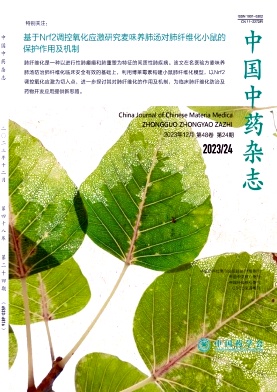[大黄酚通过NF-κB/HMGB1-PI3K/Akt/mTOR途径抑制ox- ldl诱导的巨噬细胞泡沫的机制]。
摘要
本研究旨在探讨菊醇(Chrysophanol,Chr)减少氧化低密度脂蛋白(ox-LDL)诱导的炎症和泡沫细胞形成的内在机制,并研究Chr影响冠状动脉粥样硬化的相关靶点和途径,为开发新的临床药物提供理论依据。体外培养 RAW264.7 巨噬细胞,用细胞计数试剂盒-8(CCK-8)确定处理 RAW264.7 巨噬细胞的 Chr 和 ox-LDL 的适当浓度后,用不同浓度的 Chr(10、15 μmol-L~(-1) )和 ox-LDL(含或不含 80 mg-mL~(-1))处理巨噬细胞 24 小时。将 RAW264.7 巨噬细胞分为四组:对照组、模型组(80 mg-mL~(-1) ox-LDL)、处理组(80 mg-mL~(-1) ox-LDL+10 μmol-L~(-1) Chr)和处理组(80 mg-mL~(-1) ox-LDL+15 μmol-L~(-1) Chr)。用油红 O 染色法检测各组的脂质积累情况。流式细胞术分析 CD36 的表达。用 Western 印迹法检测清道夫受体 A1 类(SR-A1)、清道夫受体 B 类Ⅰ型(SR-B1)、自噬相关蛋白 5(Atg5)的表达、Beclin-1、自噬适配蛋白 p62(P62)、微管相关蛋白轻链 3(LC3)Ⅱ与 LC3Ⅰ 的比率(LC3Ⅱ/LC3Ⅰ)、核因子卡巴 B P65(NF-κB P65)、κB 激酶抑制剂 β(IKKβ)、κB 核因子抑制剂(IκB)、高迁移率基团盒蛋白 1(HMGB1)、磷脂酰肌醇 3 激酶(PI3K)、蛋白激酶 B(Akt)和雷帕霉素哺乳动物靶蛋白(mTOR)的磷酸化。实时定量聚合酶链反应(RT-qPCR)用于检测ATP结合盒转运体A1(ABCA1)、ATP结合盒转运体G1(ABCG1)、ATP结合盒转运体G2(ABCG2)和ATP结合盒转运体G3(ABCG3)的mRNA表达水平、白细胞介素-1β(IL-1β)、肿瘤坏死因子-α(TNF-α)、HMGB1、诱导型一氧化氮合酶(iNOS)、精氨酸酶 1(Arg1)、巨噬细胞半乳糖型凝集素-1(Mgl-1)和 NF-κB P65 的 mRNA 表达水平。免疫荧光分析确定了各组 RAW264.7 细胞中 HMGB1 的定位。再次将 RAW264.7 巨噬细胞分为四组:对照组、模型组(80 mg-mL~(-1) ox-LDL)、处理组(80 mg-mL~(-1) ox-LDL + 15 μmol-L~(-1) Chr)和抑制剂组(80 mg-mL~(-1) ox-LDL+15 μmol-L~(-1) Chr+3-MA)。结果表明,Chr通过调节SR-A1、ABCA1、ABCG1、LC3Ⅱ/LC3Ⅰ比值、Atg5、Beclin-1和p62的表达水平,抑制NF-κB/HMGB1-PI3K/Akt/mTOR信号通路,有效地减少了泡沫细胞的形成。此外,自噬抑制剂 3-MA 可逆转 Chr 对自噬和 NF-κB/HMGB1-PI3K/Akt/mTOR 通路的抑制作用。总之,Chr 通过诱导自噬和调节 NF-κB/HMGB1 和 PI3K/Akt/mTOR 通路来抑制巨噬细胞炎性泡沫细胞的形成,因而具有治疗动脉粥样硬化的潜力。The aim of this study was to investigate the underlying mechanism of chrysophanol(Chr) in reducing inflammation and foam cell formation induced by oxidized low-density lipoprotein(ox-LDL) and to investigate the targets and pathways related to effects of Chr on coronary atherosclerosis, providing a theoretical basis for the development of new clinical drugs. RAW264.7 macrophages were cultured in vitro, and after determining the appropriate concentrations of Chr and ox-LDL for treating RAW264.7 macrophages using a cell counting kit-8(CCK-8), the macrophages were treated with different concentrations of Chr(10, 15 μmol·L~(-1)) and ox-LDL(with or without 80 mg·mL~(-1)) for 24 h. RAW264.7 macrophages were divided into four groups: control group, model group(80 mg·mL~(-1) ox-LDL), treatment group(80 mg·mL~(-1) ox-LDL+10 μmol·L~(-1) Chr), and treatment group(80 mg·mL~(-1) ox-LDL+15 μmol·L~(-1) Chr). Lipid accumulation in each group was detected by oil red O staining. CD36 expression was analyzed by flow cytometry. Western blot was used to detect the expression of scavenger receptor class A1(SR-A1), scavenger receptor class B type Ⅰ(SR-B1), autophagy-related protein 5(Atg5), Beclin-1, autophagy adaptor protein p62(P62), the ratio of microtubule-associated protein light chain 3(LC3)Ⅱ to LC3Ⅰ(LC3Ⅱ/LC3Ⅰ), nuclear factor kappa B P65(NF-κB P65), inhibitor of κB kinase β(IKKβ), nuclear factor of κB inhibitor(IκB), high mobility group box protein 1(HMGB1), phosphatidylinositol 3-kinase(PI3K), protein kinase B(Akt), and phosphorylated mammalian target of rapamycin(mTOR). Real-time quantitative polymerase chain reaction(RT-qPCR) was used to detect the mRNA expression levels of ATP-binding cassette transporter A1(ABCA1), ATP-binding cassette transporter G1(ABCG1), interleukin-1β(IL-1β), tumor necrosis factor-α(TNF-α), HMGB1, inducible nitric oxide synthase(iNOS), arginase 1(Arg1), macrophage galactose-type lectin-1(Mgl-1), and NF-κB P65. Immunofluorescence analysis was performed to determine the localization of HMGB1 in RAW264.7 cells in each group. The autophagy inhibitor 3-methyladenine(3-MA) was added as a control for reverse validation, and the RAW264.7 macrophages were divided into four groups again: control group, model group(80 mg·mL~(-1) ox-LDL), treatment group(80 mg·mL~(-1) ox-LDL + 15 μmol·L~(-1) Chr), and inhibitor group(80 mg·mL~(-1) ox-LDL+15 μmol·L~(-1) Chr+3-MA). The results showed that Chr effectively reduced foam cell formation by regulating the expression levels of SR-A1, ABCA1, ABCG1, the LC3Ⅱ/LC3Ⅰ ratio, Atg5, Beclin-1, and p62, and inhibited the NF-κB/HMGB1-PI3K/Akt/mTOR signaling pathway. Moreover, the inhibitory effects of Chr on autophagy and the NF-κB/HMGB1-PI3K/Akt/mTOR pathway were reversed by the autophagy inhibitor 3-MA. In conclusion, Chr exhibits therapeutic potential for the treatment of atherosclerosis by inducing autophagy and modulating the NF-κB/HMGB1 and PI3K/Akt/mTOR pathways to inhibit the formation of macrophage inflammatory foam cells.

 求助内容:
求助内容: 应助结果提醒方式:
应助结果提醒方式:


